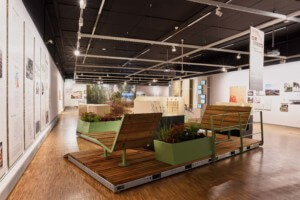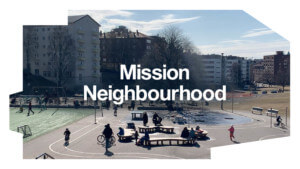Running from September 8 to November 27, the Oslo Architecture Triennale promises an in-depth exploration of many challenges facing the architectural field, including refugees, migration, homelessness; new mediated forms of domesticity and foreignness; environmental displacements; tourism; and the technologies and economies of sharing. The conference will also feature 17 speakers from across the global design scene, including Columbia GSAPP Dean and Work Architecture Company co-founder Amale Andraos, Atelier Bow-Wow Founders Yoshiharu Tsukamoto and Momoyo Kaijima, and OMA Partner Ippolito Pestellini Laparelli, just to name a few.
The Architect’s Newspaper Senior Editor Matt Shaw sat down with the curators and scholars of After Belonging Agency (Lluís Alexandre Casanovas Blanco, Ignacio González Galán, Carlos Mínguez Carrasco, Alejandra Navarrete Llopis, and Marina Otero Verzier), the group organizing the Triennale, to learn more.
Matt Shaw: First, I’d like to ask about the current geopolitical context in which the exhibition is happening. Among many other symptoms of advanced globalization, Europe is struggling with how to deal with a wave of migration, while in the United States one presidential candidate is calling for building more walls along the Mexico border and accuses the other candidate of wanting a “borderless world.” How is the exhibition timely in this sense?
After Belonging Agency: From the outset, our aim has been to focus on questions of contemporary relevance—in this case, questions addressing the role of architecture in the construction of communities and territories. Those preoccupations coalesced around a critical inspection of architecture’s changing relation to current forms of belonging. The situations that you mention—what media has come to call the refugee crisis or the rise of populist measures against migration like the one led by Trump in the US—suggest the timeliness of interrogating architecture’s relation to stability, property, and identity—ultimately, architecture’s relation to belonging. However, for us, it is important not considering these events as isolated historical phenomena, nor responding to them under a paradigm of crisis or the rhetorics of urgency. We rather want to understand what is the role of architecture in the increasing circulation of populations, goods, and information on a global scale, as well as the effects of this circulation on architectural practice.
How is the exhibition organized?
In order to develop the questions at stake in the curatorial premises, we defined two main areas of work: On Residence and In Residence. On Residence documents the spatial conditions that shape our ways of staying in transit as well as the redefinition of our contemporary spaces of residence. Here architecture takes different forms beyond the building, ranging from arrangements of objects and their logistics to territorial configurations and digital systems of organization. The contributions to the exhibition gravitate around five areas: Borders Elsewhere, Furnishing After Belonging, Sheltering Temporariness, Technologies for a Life in Transit, and Markets and Territories of the Global Home. Conceived as an accumulation of evidence and speculations, the exhibition unveils the multiple scales and media involved in the architectures of contemporary forms of residence, and how these architectures convey new articulations between individuals, objects, technologies, collectives, and territories.
Additionally, the curatorial framework is furthered by a closer inspection of specific case studies. This results in the In Residence program and exhibition. Reports have been commissioned for each of the ten selected sites, outlining diverse ways of describing the architectures they include. In addition, we launched a Call for Intervention Strategies for five of those sites located in Oslo and the Nordic region. Understood as tactical and long-term forms of engagement with the sites, these interventions have been developed throughout the last nine months. By bringing together these different approaches, the In Residence exhibition aims to test the capacity of architectural expertise to respond to these changing realities.
What are the venues for the Triennale? How did you choose them and how did they shape what we will see?
The Triennale takes advantage of the architectures of the city of Oslo. Opening on September 8, the After Belonging: On Residence exhibition is set at an old warehouse now housing the Norwegian Center for Design and Architecture (DogA), and the After Belonging: In Residence exhibition is displayed in a glass pavilion addition to the National Museum designed by Sverre Fehn. The After Belonging Conference will be celebrated on September 9 at the Oslo Opera House by Snøhetta. Some additional events will happen at the Oslo City Hall.
Yet, other architectures critical to understand the transformation of belonging are being mobilized both in the city of Oslo, the Nordic region, and around the globe. These architectures are addressed within the In Residence program both by the reports and intervention strategies. For example, a Triennale visitor, upon arriving at Oslo, will encounter an architectural intervention developed at Gardermoen Airport or will be able to engage with the different strategies for an asylum seekers’ center in the neighborhood of Torshov, in the In Residence exhibition.
Each of the member organizations that are part of The Oslo Architecture Triennale plays a role within the program, adding new locations. In addition to The National Museum, DogA, and the Oslo School of Architecture and Design (AHO) will also host events during the opening weekend and a lecture series throughout the duration of the Triennale.
What role does digital technology and communication play in the exhibition, and what is its relationship to the more physical parts of architecture that you will display?
Digital technologies are central to the questions addressed by the curatorial topic, as well as a key component of the curatorial strategy.
On the one hand, the role of architecture in the articulation of belonging is intertwined with the development of the digital technologies that define everyday realities and global imaginaries. Some of the pieces in the On Residence exhibition reflect upon the media and modes of organization shaping networked geographies, analyzing the social bonding and mutualization systems that they enable. Moreover, some of the case studies addressed in the In Residence program and exhibition are particularly concerned with technological processes. In Lagos, for example, we consider how videotapes and sound recordings circulating in social media foster spiritual and social affiliation. In fact, the spaces hosting these forms of religious congregation can be both understood as broadcasting platforms and reception nodes.
But In Residence looks also at the effects of digital platforms like Airbnb and all the so-called sharing economies upon the built environment, ranging from the monetization of domestic spaces to the real estate processes they trigger in the city. Some intervention strategies instrumentalize the possibilities offered by these platforms with other purposes. This is the case of bnbOpen, which—through an app that facilitates asylum seekers’ access to accommodation offered by the inhabitants of Oslo—explores alternative ways of meeting asylum seekers’ needs with new notions of adaptability and hospitality.
In fact, the spaces resulting from the technological mediation of financial structures are of great importance in understanding new ways of being together. These spaces are addressed in a section of the After Belonging Conference that we have titled The Digital and the Real Estate. This section conjoins scholar Reinhold Martin and the collaborative effort of OMA’s Ippolito Pestellini Laparelli and digital invention studio Bengler. In a project especially set up for the On Residence exhibition, OMA and Bengler investigate the accelerating influence of digital sharing platforms and their pervasive impact on the built environment.
On the other hand, interaction through digital technologies—namely, social media and other web platforms—have been key for our curatorial proposal throughout these last two years: in order to convey a global conversation in anticipation of the Triennale. Not to talk about the central—even if obvious—role of digital meetings in making this project possible. With curators living in two different time zones distant from the Triennale’s location, we consider the curatorial project as a global architectural practice in its own right.
What auxiliary events will be planned in the city, both at the opening and throughout the length of the Triennale?
Together with the On Residence and In Residence exhibitions, the After Belonging Conference and the Triennale publication (which we will launch at the opening), there are two other key platforms within the Core Triennale Program: The Academy and The Embassy. The Academy is a forum organized by the AHO, which brings schools and students from around the world into a global dialogue and knowledge-sharing experiment that will reflect on the topics of After Belonging. Visitors to the Triennale will be able to see the results of the students’ work in a public presentation at the Stenersen Museum on Friday, September 16.
During the opening weekend, we will launch The Embassy in an event on Sunday 11. Its main program will be developed during the Triennale’s closing week. The New World Embassy: Rojava—a collaboration between Studio Jonas Staal and the Democratic Self-Administration of Rojava—will manifest as a temporary embassy that will be constructed in Oslo with the aim of discussing the ideals of “stateless democracy” developed by the communities of the autonomous region of Rojava, northern-Syria. The embassy will consist of a large-scale oval shaped architectural structure, designed as an “ideological planetarium.”
In addition to those, more than 40 events, conversations, workshops and smaller exhibitions throughout the city will echo the topics of the Triennale during the opening weekend, and more as the program unfolds until the end of November. Some of them are coming from a Call for Associated Projects, while others are directly organized by the Triennale’s members or other collaborating institutions. These events range from an exhibition on Chinese communities around the world to a discussion addressing the contemporary status of the so-called European project.
What else should visitors know about the opening?
Be ready: there will be a party every day! Partying is a form of belonging.
For more details on the Triennale, visit their website here.









